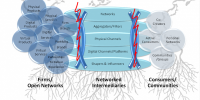Look out for our latest article in CEO Today on why you should be taking a second look at who your competitors really are. Click here to access the electronic
ContinueTracey Keys
Tracey is a Director of Strategy Dynamics Global SA. She has over twenty years of experience as a consultant and executive, focused on complex strategy and organisational issues, and has worked with leading companies globally. Prior to founding Strategy Dynamics Global SA, Tracey worked with senior executives at IMD, and has held senior roles at the BBC, Booz &Co., Deloitte & Touche and Braxton Associates, as well as being an active advisor to a number of start-ups. Tracey is a Fulbright Scholar and holds an MBA from The Wharton School, University of Pennsylvania where she was distinguished as a Palmer Scholar.
Robots and smart machines have been the focus of a number of articles in the Financial Times over the last week. Click here to see our letter published by the
Continue
GT BRIEFING: February 2013 -- The Workforce of the Future
February 2013:
An estimated 600 million new jobs need to be created worldwide in the next 15 years, in particular in Asia, Sub-Saharan Africa, to keep up with the massive need for employment globally. (Source: 2013 World Development Report). However the labor market and our future workforce is a world of contradictions. While companies worldwide are crying out for new talent and skilled workers, they are unable to fill vacant positions, even as unemployment rates have been skyrocketing. How can we reduce this mismatch between the skills of workers and the talent companies are seeking?
One route is to help prospective employees build the knowledge they need to secure the jobs on offer. The good news is that building knowledge offers almost limitless potential. In 2009 venture capitalist Brad Burnham put it like this: "Knowledge is, as the economists say, a non-rival good. If I eat an apple, you cannot also eat that same apple; but if I learn something, there is no reason you cannot also learn that thing. Information goods lend themselves to being created, distributed and consumed on the web. It is not so different from music, or classified advertising, or news." (Source: Mashable).
However, building knowledge for today’s jobs is not likely to be enough to keep up with the rapidly changing future of work. Globalization and ease of mobility as well technological advancements are changing the characteristics of the global labor market, the nature of jobs themselves, and how work will be done in future. These changes create opportunities as well as challenges for employers and employees, for example when managing cultural diversity becomes an integral part of everyday work life. Add to this the impact of game-playing and tech-savvy younger generations who are starting to enter the world’s workforce in larger numbers. However, for these generations there is a substantial risk of disenfranchisement as youth unemployment rates around the world remain high – discouraging some young people from participating in the workforce and potentially stirring social unrest.
The workforce of the future will look radically different in just a few short years. Are you ready?
Continue
Marketing Magazine in the UK has just published The Owneress Economy as part of their Forward-Thinking Essays series. To read the article please click here.
ContinueThe Yale Center for the Study of Globalization through its YaleGlobal online service has just launched an ebook A World Connected: Globalization in the 21st Century which is well worth
ContinueJanuary 2013: Proving yet again that evaluating trends and forecasts requires a healthy dose of common sense, a high tolerance of ambiguity and the ability to determine what is most relevant for you and your organization, the world continues to revolve after the end of the Mayan calendar, the US fiscal cliff (at least round one) and a host of geopolitical shifts. As we look forward to 2013 and beyond, these traits will be more important than ever as new and exciting trends shape how we live, work, consume and think. Typing Trends for 2011 into Google on January 1st 2011 gave us around 46 million results but typing Trends for 2012 gave us on January 1st 2011 gave us around 808 million and typing Trends for 2013 into Google on January 1st 2013 gave us around 1030 million results! The number of opinions about what’s in store in the forthcoming year is exploding – particularly in a year where we face increasing uncertainty over everything from the geopolitical world order (renewed tension in the Middle East and the China South Sea?) to the economy (recession or not? global or not?) to consumer behavior (to buy or not to buy?). With so many diverse forecasts it can be tough to sort the noise from the merely interesting to the extremely important.
So, as here’s our annual round-up of where you can find some of the more interesting and important trend forecasts and ideas for 2013. As always, bear in mind that in a world as uncertain as ours such forecasts are not meant to be accurate. Treat them as directional and informed opinions on potential opportunities and challenges that can offer new perspectives to supplement your own thinking on what might be possible, feasible and desirable. And look at both sides of the arguments – as uncertainty and volatility grow, it’s more important than ever to think through all the options! Don’t forget to look at top trends outside your own industry or market space – these may well cross over sooner than you think! We will pick up on many of these trends in our 2013 GT briefings along with examples of how they are being – or could be – translated into action.
ContinueI’ve just read the new book from Guy Kawasaki and Shawn Welch, APE (Author, Publisher, Entrepreneur): How to publish a book – my major criticism: It wasn’t out three months
ContinueDecember 2012: Why care about Global Trends? Think about Kodak. They invented the digital camera, but side-lined it to focus on their core consumable film business – only to realize too late that their competitors were not who they thought they were and that consumer behavior had shifted. Take Hurricane Sandy, a deadly reminder of the world’s shifting climate patterns, following droughts across the globe – emphasizing the need for new ways to manage the world’s resources and environment. Or take the growing levels of social unrest over rising inequality, austerity, jobs, political ineptitude, institutional failure and more. Power is being redistributed away from traditional institutions that have failed to deliver progress, towards communities and individuals, as well as businesses.
It’s an uncertain and unstable world, one where leaders and organizations need to have a point of view on the future and to act today to address long-term trends. Access to resources, power, value creation, and values and beliefs are all becoming more distributed. The business of the future will not be at the center of the playing field – the consumer will, as cross-industry competition, distributed production and networks become the norm, underpinned by social technologies. Let’s look at 10 key trends to watch for the next year, highlighted in The Global Trends Report 2013.
If you want the quick summary to share with your colleagues, you can find it in The Economist here.
To access the related presentation, 10 Key Trends to Watch in 2013 click on this icon.![]()
Looking forward to the year ahead — and beyond — is always a tough challenge. We greatly enjoy The Economist’s The World in 2013 (and prevoius and hopefully future years)
ContinueHere’s another quick preview from The Global Trends Report 2013, due out in just 2 days on November 14th. Look out for it soon. Social needs, mobility, communities, societal impact
Continue





